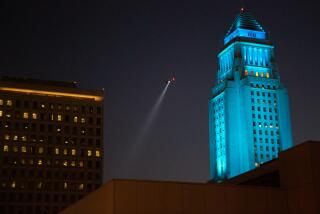GAO criticizes TSA program to monitor passenger behavior
- Share via
WASHINGTON — The Transportation Security Administration, already under scrutiny after one of its agents was shot to death at Los Angeles International Airport this month, has spent nearly $1 billion on a passenger behavior monitoring program that has not been scientifically proven to work, a key government watchdog agency said Thursday.
The Government Accountability Office report was released before a Capitol Hill debate between lawmakers and TSA officials over whether the agency’s so-called SPOT program for monitoring people at airports is worth the cost, and whether it should continue for three more years to help identify suspicious people like the gunman who killed one TSA agent and wounded two more as well as a civilian on Nov. 1.
“The TSA has limited information to evaluate this program,” Stephen M. Lord, a GAO managing director, told a House Homeland Security subcommittee. “They hope it works. But from the GAO’s point of view, the program should not be based on hope and faith.”
TSA Administrator John Pistole strongly defended the $900-million program and urged its expansion, even though it failed to detect and stop the LAX gunman before he opened fire in Terminal 3. “I don’t want to take away a layer of security that may identify the next attack,” Pistole said.
Paul Anthony Ciancia, accused of being the gunman, was shot by a responding officer and is hospitalized in fair condition.
But Rep. Bennie Thompson of Mississippi, ranking Democrat on the Homeland Security Committee, said no more taxpayer money should be spent on SPOT merely “to see if it works.” He added, “We cannot continue to fund programs with the hope that they will work.”
Started in 2007, the Screening of Passengers by Observation Techniques program, or SPOT, trains and deploys about 3,000 behavior-detection officers to 176 of the more than 450 airports in the U.S. that are TSA-regulated.
The GAO found that a Homeland Security Department study used to validate SPOT was flawed and inconclusive, that it used improper controls, and that there was no scientific proof the program could identify potential assailants.
In the LAX attack, Pistole said, events transpired too quickly for officers to spot the gunman’s behavior before he started shooting. “It was just a matter of seconds,” he said.
Committee Chairman Michael McCaul (R-Texas) said no armed police officers were within a three-minute radius of the shooting, calling that “very significant.” No TSA officers at the security checkpoint pushed the panic button to alert local authorities, he said; instead, they tried to call police on a land line.
“But the phone was understandably abandoned during the [airport] evacuation because it wasn’t mobile,” McCaul said. “Police responded based on an airline contractor rather than the TSA. The gunman had four minutes and 150 rounds, and that is a long time. It’s extraordinary that more lives were not taken.”
Rep. Maxine Waters (D-Los Angeles) said she was concerned about the decision earlier this year to shift armed police from fixed posts at TSA checkpoints to other airport patrol duties. Waters, whose district includes LAX, cited a letter to the TSA from the Los Angeles Airport Peace Officer’s Assn. that said it was virtually impossible for individual officers to respond quickly to a problem at a screening checkpoint if they were responsible for patrolling an entire terminal.
Waters said a decision was made in April to waive the requirement for fixed-post officers at LAX. “In any event, there was apparently no fixed-post officer stationed at the affected LAX checkpoint when the shooting began,” she said.
Los Angeles Airport Police Chief Patrick Gannon, who decided to remove officers from the checkpoints, said it reduced the predictability of airport security procedures and enhanced safety by placing officers in more central positions.
J. David Cox Sr., national president of the union that represents TSA workers, the American Federation of Government Employees, issued a statement in support of the STOP program. “An imperfect deterrent to a terrorist threat is better than no deterrent at all,” he said.
Cox also called for training some TSA employees as law enforcement officers. “The tragedy at LAX was an unfortunate reminder that our airports aren’t as safe and secure as they could be,” he said.
Serrano reported from Washington; Weikel from Los Angeles.
richard.serrano@latimes.comdan.weikel@latimes.com
Serrano reported from Washington; Weikel from Los Angeles.
More to Read
Sign up for Essential California
The most important California stories and recommendations in your inbox every morning.
You may occasionally receive promotional content from the Los Angeles Times.












